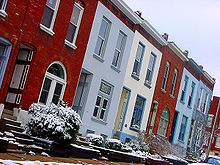Lafayette Square, St. Louis
Lafayette Square | ||
|---|---|---|
ZIP code(s) Part of 63104 | ||
| Area code(s) | 314 | |
| Website | lafayettesquare.org | |

Lafayette Square is a
The neighborhood is one of the oldest in St. Louis. When it was developed, it was one of the most fashionable places to live. It declined after a tornado devastated the area in 1896. Later, industrial encroachment and highway construction further weakened the neighborhood.
Since the 1970s, St. Louis residents have been buying and renovating the older homes in Lafayette Square. As of 2006, most of the homes have been restored and there are many shops and restaurants.
History
Since
In
From the 1850s to the 1870s money from neighborhood residents and city coffers went toward improvements of the Square. These included “trees, shrubbery, graveling, fencing[,]” and outdoor concerts. One newspaper called for more funds for improvement, writing that the Square “only needs to be properly improved to be one of the most attractive places in the United States.” During the American Civil War, Lafayette Square was spared from the riots that plagued other city parks. With the end of the war, martial law also ended, and lot purchasing picked up.
The first
"In looking about the city and noting its improvements, we have been struck with the great progress attained in the vicinity of Lafayette Park. Within two years some of the finest residences in the city have been erected and the work is still going on. The beauty of the grounds, the elevation above the city, the character of the buildings, the beautiful shade trees, wide streets, and accessibility to the city by two lines of horse cars, the restrictions (by Statute) upon the erection of objectionable buildings or the carrying on of objectionable business, all combined should make this quarter the most desirable in the city for residence."

The 1870s was a time of flourishing for the Square marked by the continuing development of Benton Place on the north, and regular concerts on Thursdays and Sundays routinely attracting concertgoers numbering in the thousands and sometimes more than ten thousand. At one point, the park was tended to by thirteen
On May 27, 1896, Lafayette Square was largely
In 1923, the
Lafayette Park
The 29.95-acre (121,200 m2) park was created by city ordinance 2741 in 1838. The park was named in honor of the
The land was part of the St. Louis Common. When the Common was divided in 1836, an ordinance preserved the 29.95
Demographics
| Year | Pop. | ±% |
|---|---|---|
| 1990 | 1,962 | — |
| 2000 | 1,761 | −10.2% |
| 2010 | 2,078 | +18.0% |
| 2020 | 2,164 | +4.1% |
| [4] | ||
In 2020 Lafayette Square's racial makeup was 77.7% White, 11.4% Black, 2.4% Asian, 7.3% Two or More Races, and 1.2% Some Other Race. 3.3% of the population was of Hispanic or Latino origin.[5]
| Racial composition | 1990[6] | 2000[7] | 2010[8] | 2020 |
|---|---|---|---|---|
White |
74.8% | 68.4% | 80.5% | 77.7% |
Black or African American |
24.2% | 28.1% | 13.5% | 11.4% |
| Hispanic or Latino (of any race) | 1.4% | 3.0% | 3.3% | |
Asian |
1.0% | 2.6% | 2.4% |
See also
- Lafayette Square Historic District (St. Louis)
- LaSalle Park, neighborhood between the Lafayette area and Soulard neighborhood
- Peabody–Darst–Webbe, St. Louis, neighborhood to the east of Lafayette Square
- Soulard, St. Louis, nearby area with a large public market
- Streetcars in St. Louis, Missouri, an early means of mass transit, to and from Lafayette Square
- Tower Grove Park, the large park constructed on private land, now public, a short distance west of Lafayette Square
References
- ^ "2020 Census Neighborhood Results".
- ^ Neighborhood Data Profile for Lafayette Square Archived 2007-11-04 at the Wayback Machine
- ^ Lafayette Park, stlouis-mo.gov
- ^ "Census".
- ^ "City of St. Louis" (PDF). Retrieved 2021-09-16.
- ^ "Lafayette Square Neighborhood Statistics". City of St. Louis.
- ^ "The City of St. Louis Missouri". City of St. Louis.
- ^ "The City of St. Louis Missouri". City of St. Louis.
Sources
- David T. Beito, "The Private Places of St. Louis," in Beito, Peter Gordon and Alex Tabarrok, The Voluntary City: Choice, Community, and Civil Society (Ann Arbor: University of Michigan Press, 2002), p. 47-75.
- John Albury Bryan, Lafayette Square: The Most Historic Old Neighborhood in St. Louis (2d ed. rev. Landmarks Assn. of St. Louis, Inc. 1969) (Lafayette Square Press 1962).
- Timothy G. Conley, Lafayette Square: An Urban Renaissance. Photography by Barbara Elliott Martin (Lafayette Square Press 1974).
- DAILY DEMOCRAT, June 27, 1870.
- Where We Live: A Guide To St. Louis Communities (Tim Fox ed. Missouri Historical Society Press 1995)
- Russell Kirk short story "Lex Talionis" which appears in Ancestral Shadows: An Anthology of Ghostly Tales
- National Register of Historic Places - Nomination Forms
- "Lafayette Square" (PDF). Missouri Department of Natural Resources. Retrieved 2008-05-30.
- "Lafayette Square Historic District" (PDF). Missouri Department of Natural Resources. Retrieved 2008-05-30.
External links
- Lafayette Square - Lafayette Square website.
- Lafayette Square Photograph Collection at St. Louis Public Library
